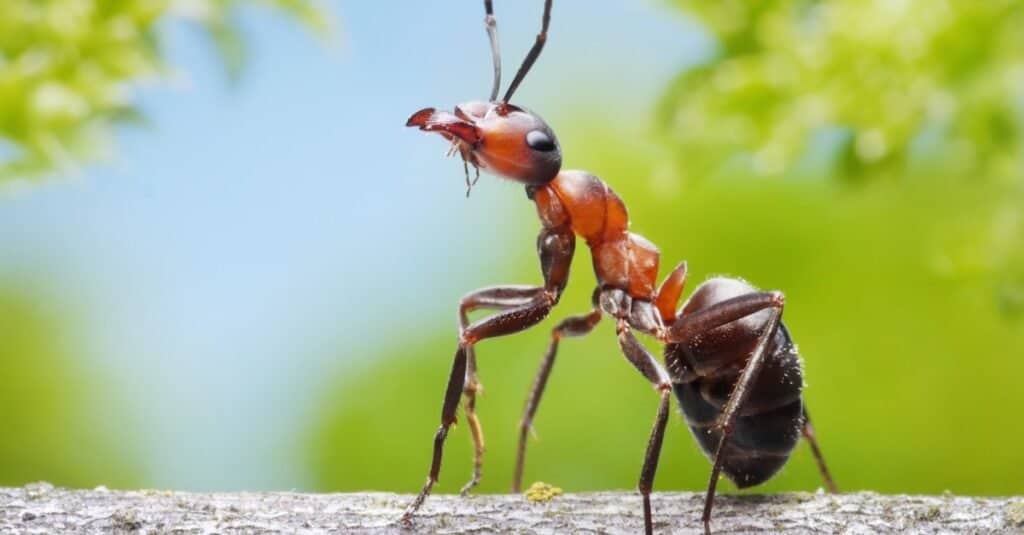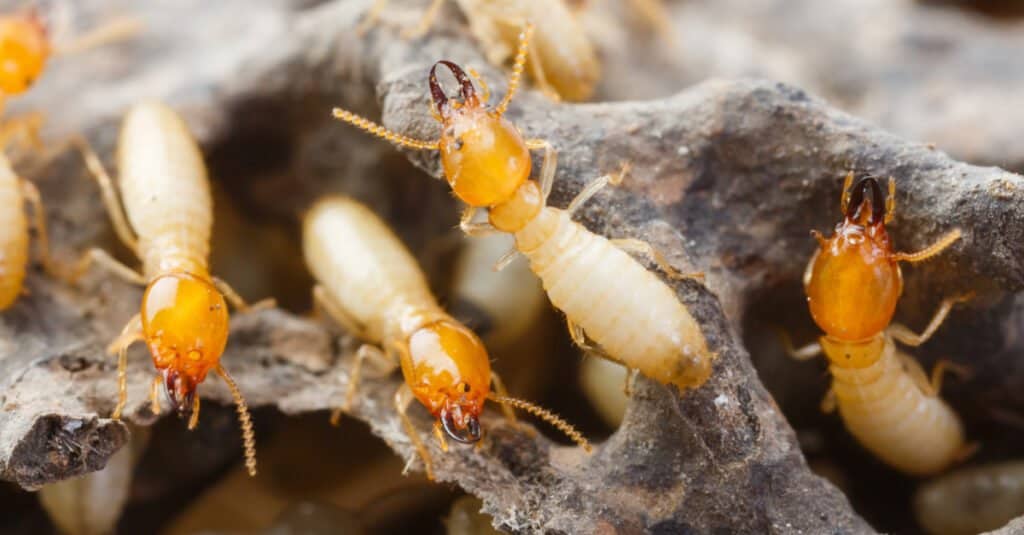Flying ants vs. termites are often mistaken for each other, and it’s certainly an easy mistake to make when they are both in their flying stages. Even when they not flying they live in mostly the same locations and habitats and can look the same shape and color at first glance. However, they’re not quite the same.
So, just what sets these two small insects apart? Well, they have vastly different wings and different shaped antennas and abdomens. Not only that, but one mates for life and one doesn’t. In fact, for one of them, the male only lives a few days after mating! Join us as we discover all of the differences that separate flying ants vs. termites!
Comparing Termites vs Flying Ants
Although flying ants and termites both fly, they are not typical flying insects and only fly at certain times of the year when they are mating and setting out to start new colonies. In fact, flying ants are just ants that have grown wings for this exact purpose. However, despite their similarities, there are some key differences that make distinguishing the two much easier.
Check out the chart below to learn a few of the main differences.
| Termites | Flying Ants | |
| Size | Up to 1 inch long | Between 0.1 and 2 inches |
| Location | Every continent except Antarctica | Everywhere except Antarctica, Greenland, Iceland, and some small island nations |
| Color | White, dark brown, or black | Red, reddish-brown, or black |
| Antenna | Straight | Bent |
| Wings | Both pairs equal size and length, approximately twice the length of their body | Wings are proportionate to their body, second pair much smaller than first pair |
| Abdomen | Broad, straight abdomen | Thin abdomen, pinched waist |
| Diet | Dead plants and trees | Leaves, seeds, nectar, and small insects |
The 6 Key Differences Between Flying Ants and Termites

Ants grow wings in order to mate and create a new colony – turning into flying ants
©iStock.com/Antrey
Flying Ants vs Termites: Size
Termites can range in size from one-eighth of an inch up to one inch long. It depends on the individual species of ant, but flying ants usually range between 0.1 and 2 inches long, although some can be larger.
Flying Ants vs Termites: Color
Termites are usually either a creamy white, dark brown or black color. Flying ants are generally red, reddish-brown, or black.
Flying Ants vs Termites: Antenna
One of the main differences between flying ants and termites is the difference in their antennas. Termites have straight antennas while flying ants have bent antennas which look like they have elbows in them.
Flying Ants vs Termites: Wings
The biggest and most noticeable difference between flying ants and termites is their wings. Although both have two pairs of wings they differ vastly in size. Termites have large wings which are approximately twice the length of their bodies. However, both pairs are the same size and length. Flying ants have wings that are much more proportionate to the size of their bodies, but their second pair is much smaller than their first pair.
Flying Ants vs Termites: Abdomen
Another noticeable difference is the appearance of their abdomens. Termites have a broad, straight abdomen while flying ants have a thin abdomen and a pinched-in waist.

Termites have round-shaped abdomens
©7th Son Studio/Shutterstock.com
Flying Ants vs Termites: Diet
Termites are detritivores which means that they feed on dead plants and trees, although wood makes up the majority of their diet. They get their nutrients from cellulose which is found in wood and plants. Flying ants eat a range of leaves, seeds, nectar, and small insects such as spiders.
FAQ’s (Frequently Asked Questions)
Are termites and flying ants related?
No, although they are both insects, they are not closely related. Flying ants are from the order Hymenoptera which is a large group of insects and includes wasps and bees. Termites are from the order Blattodea which consists of only termites and cockroaches.
Are flying ants just ants with wings?
Yes, flying ants are essentially just ants with wings. They are males and young queens who are setting off to start a new colony. This is so that the queens can mate with males from a different colony. These winged individuals are known as alates. The wings usually develop over a few weeks, turning ants into flying ants. Once they have their wings, flying ants take to the air to search for a mate, and once they have found a mate, the act of mating is usually done in the air – known as the nuptial flight. Once they have successfully mated, queens usually chew off their wings and begin to search for a suitable spot to nest and begin a new colony. Males only exist for the purpose of mating and generally die a couple of days later.
Do termites mate for life?
Yes, quite often they do. Unlike ants, where the male only lives for a short while after mating, termite colonies have a resident king and queen. The pair are monogamous and usually mate for life. Termite alates leave their colony to find a mate, and once they have found a mate they search for a suitable nest spot. The new king and queen only mate once they have found their nest and spend the rest of their lives in it. The king is needed to provide a constant supply of sperm to the queen.
Do flying ants have any predators?
Yes, dragonflies are the main predators of flying ants, as are spiders, birds, lizards, and other insects.
Do termites have any predators?
Yes, ants are one of the main predators of termites, but spiders, scorpions, dragonflies, crickets, cockroaches, spiders, lizards, frogs, and toads also prey on them.
Do flying ants and termites live in the same habitat?
Yes, they both live in similar habitats. Termites can nest either underground, in tree stumps, in tree tops, or in any structure that is made from wood. The individual species of ant determines exactly what habitat they live in, but flying ants are usually found in and around trees and vegetation. However, it’s important to remember that flying ants only have their wings for a short time and spend most of it looking for a mate.
The photo featured at the top of this post is ©
Thank you for reading! Have some feedback for us? Contact the AZ Animals editorial team.






